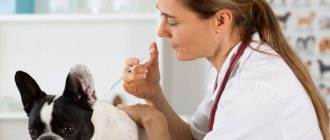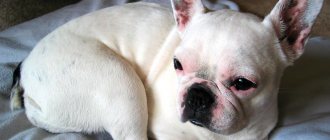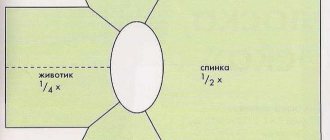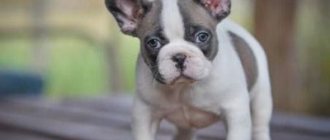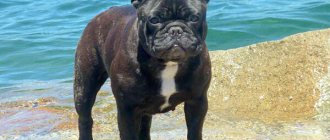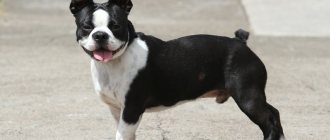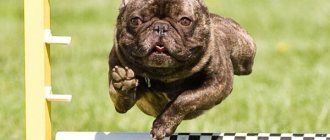The French bulldog, with its cute and attractive appearance, quickly won the hearts of dog lovers. But although caring for them is not as difficult as, for example, long-haired dog breeds, you still need to be on alert.
The maintenance of these small and stocky animals has its own nuances; they require constant love and care. Particular attention should be paid to the ears, which among owners are called “bat ears.”
Breed standard: at what age do ears stand up?
Dogs usually develop ears when they are 3-4 months old, but it can also happen earlier. There are examples when the setting took place after 6 months and even later, but these are exceptions rather than the standard.
There is no need to worry ahead of time if this does not happen, because perhaps your pet’s ears are simply heavier and they need a little more time.
Care and walking of the French bulldog
The French bulldog appeared relatively recently in our country.
Nevertheless, this animal has already established itself as an excellent companion dog. Caring for a French bulldog, like any decorative dog, takes a lot of time and effort from its owner. The animal must be walked and bathed regularly.
Combing
The French Bulldog's coat is very short, but it requires constant care. A small puppy's fur is not only short, but also sparse, so many owners prefer not to waste time combing it. This position is largely erroneous and is not approved by experienced dog breeders who know that a puppy’s coat needs daily care.
The coat of a French bulldog must be carefully looked after using special hygiene products. It is recommended to do this every time after walking. By teaching your puppy to be calm about the grooming procedure, you will thereby save yourself and your ward from many unpleasant incidents in the future.
When caring for a French Bulldog's coat, you should not use a comb, as its hard, sharp teeth can seriously injure the dog's delicate skin. Therefore, before you bring home a small pet, try to get a set of hard and soft brushes designed specifically for caring for the hair of short-haired dogs. Brushes are the main tool for grooming bulldogs. They come in large and small, hard and soft. Large ones are used to comb out debris from a dog’s fur, and small ones are used to give it a shine.
the washing up
During walks, especially in the rainy season, the coat of a French bulldog can become very dirty, and cleaning it with a brush becomes very difficult, and often impossible. In such a situation, it is best to bathe the dog. If the weather outside is warm and dry, it is recommended to wash your pet as little as possible.
Detergent
The detergent used to wash your dog should not dry out the skin. If you don't have a special pet shampoo and are going to use a regular one, choose one that is designed for dry hair and contains a rinse.
Shampoos for short-haired dog breeds with conditioner and rinse are most suitable for caring for the coat of a French bulldog.
There are a lot of such shampoos, so try to consult with your veterinarian or other dog owners before making your final choice.
Rinsing
To ensure that the dog’s fur lies flat and shiny after washing, it is recommended to rinse it with a weak solution of acetic or citric acid, which will also protect the dog from infection with external parasites. It is prepared as follows: add 1 tablespoon of citric or acetic acid to 1 liter of hot water; the resulting solution is thoroughly mixed and then cooled to a temperature of 40–45° C.
Oral hygiene
Healthy, beautiful teeth are a dog’s pride. Caring for them is the main concern of the owner of a French bulldog. Despite the fact that dogs love to chew bones, they should be given to your pet very rarely, as this quickly wears down bulldogs’ teeth, turning into uneven “stumps.” According to the standard, a full set of teeth is required for a French Bulldog. Underdeveloped canines, dark tooth enamel, and symptoms of tooth decay are some of the defects that can prevent a bulldog from being accepted at a dog show.
The French Bulldog's coat is smooth and shiny.
If, when changing teeth, the root of a baby tooth has not completely dissolved, it must be removed in a veterinary clinic, as it will prevent the development of a permanent tooth and the dog will definitely have problems with bite in the future.
To remove a baby tooth yourself, without the intervention of a veterinarian, just rock it for a few minutes every day, after wrapping it in a clean cloth or piece of gauze. A loose tooth can be removed from the jaw by pulling it away from the throat.
Inflamed gums are usually treated with a weak solution of potassium permanganate. However, treating this disease at home is still not recommended. It is best to contact a veterinary clinic, where the animal will receive the required help. The same should be done if signs of caries are detected in a bulldog. If the tooth is very badly damaged, the affected dog often rubs its muzzle with its paws, refuses to eat and begins to chew on objects around it.
Under no circumstances should you accustom your puppy to treats. Cakes, sweets, pieces of cake and sweet buns will have a bad effect on his health and behavior. By quickly gaining extra calories, the animal will lose mobility. The dog will be spoiled and capricious. Her teeth will become yellowish, covered with tartar, and begin to quickly deteriorate.
To keep your dog's teeth strong and healthy, calcium-containing foods (cottage cheese, milk), fresh tomatoes and raw bones should be included in its diet.
To prevent dental diseases, it is recommended to regularly give your dog the medications listed in the table below.
table 2
Drugs used to prevent dental diseases
You can prevent the development of caries, the formation of tartar and get rid of yellow plaque if you regularly brush your dog’s teeth with toothpaste without a strong odor or strong taste. To do this, take a small wooden stick, one end of which is wrapped in a layer of cotton wool, dipped in toothpaste or sprinkled with a special powder made from crushed chalk, baking soda and citric acid.
After finishing brushing, the French Bulldog's teeth should be thoroughly wiped with a soft paper napkin and a gauze swab.
Under no circumstances should you allow your pet to swallow toothpaste or powder, as this will cause stomach upset.
Tartar causes irritation and inflammation of the gums and has a destructive effect on tooth enamel. Ultimately, this can lead to complete tooth loss.
If small fragments of twigs, bones, tissue or other foreign objects are stuck in your pet's teeth, they should be carefully removed (using tweezers or dental floss if necessary) as they can damage tooth enamel and injure the gums.
Ear hygiene
A dog's hearing is developed many times better than that of humans. Its range is so wide that it allows the French Bulldog to pick up even sounds that are inaudible to most other animals. This is what scientists studying dogs first noticed.
The ability of dogs to perceive ultrasound has made it possible to use an ultrasonic whistle during hunting and training, which allows for silence and helps the French bulldog quickly master commands.
The French Bulldog's ears need to be cleaned regularly as dirt and wax constantly accumulate in them. To do this, drop a little warm vegetable oil into your pet's ears.
Why don't my ears stand up?
This can happen if the puppy is not purebred. You may have purchased it at the market or from a private breeder. If you are confident that the puppy is purebred, then there are completely different reasons.
Often the ears do not stand up in dogs of overly loving owners who smooth out their pet so much that they remain in a hanging position.
Care and walking of the French bulldog
By the age of 4 months they will become almost the same as those of an adult dog; of course, the appearance of a puppy with such ears looks funny and causes a smile and tenderness.
When the cartilage tissue in this part of the body has the necessary density, the ears stand up without any difficulty. Owners will notice that their inclination gradually becomes different until they are fully straightened and stand upright. In certain situations, the inclination of the ears changes sharply, the raising stops, or the already installed ears suddenly begin to droop. Why can such a phenomenon occur?
How to put on a dog's ears: tips
It is not recommended to interfere with the setting of the ears until at least three months have passed since the puppy’s birth. At this time, it is better to provide him with proper nutrition, which will help with this. You need to give more calcium, but you shouldn’t get carried away with it. From the whole variety of products, 3 main ingredients can be distinguished:
- cottage cheese,
- kefir,
- soft cartilage containing gelatin.
If nutrition does not help and the ears do not stand up for a long time, you should consult a specialist. But if you do not have the opportunity to do this, then you can cope on your own by resorting to the gluing procedure. For this you will need:
- bandage,
- wide adhesive plaster,
- cotton wool
The adhesive plaster can be used either medical or paper. Everyone chooses the one that suits them best. When the paper bandage is peeled off, less hair is pulled out, but it holds a little worse than a medical one.
Ear gluing process
- First, you need to roll up thick rolls from cotton wool. Their height should be slightly larger than the height of the ear, and their width should be approximately 5 cm.
- The resulting cotton rolls should be wrapped in a bandage to keep them in place.
- Insert them into the puppy's ears and wrap them around the rolls, securing them with adhesive tape.
- Use two strips of adhesive to connect the ears in a strictly vertical position, making sure that they are symmetrical relative to each other.
The bandage should be worn for 7 to 10 days. If the result is not noticeable after removal, the procedure should be repeated.
Attention! While wearing the headband, you must not stroke the dog’s head!
When do a French Bulldog's ears stand up?
The ears of this breed should stand upright, symmetrically, with the insides facing forward and not to the sides.
A French Bulldog puppy's ears usually stand up at about 2 months. Around this age, the owner takes the baby from the breeder, but if the ears are still hanging, there is no need to worry: at what time a French bulldog’s ears stand up is determined by the individual thickness and fleshiness of the cartilage.
Sometimes you should feed the puppy calcium and calcium-containing products - cottage cheese, kefir. If by 3-4 months the French bulldog’s ears still do not stand up, they resort to the procedure of gluing them using a bandage made of plaster, bandage and cotton rolls. A veterinarian or breeder will help you make the bandage. The pet should wear it for 7-10 days. Sometimes the procedure has to be repeated. Owners should not stroke or rub their pet's ears until they have assumed a stable vertical position.
It may happen that your French Bulldog's ear falls off. This often happens in puppies, and breed experts usually advise owners not to worry about this. You can increase the dose of calcium for your baby, but so as not to overdose. It is also useful to give him cartilage containing gelatin and make a supporting bandage. If all this does not give the desired results, consultation with a veterinarian is necessary.
A dog's hearing is very sharp and subtle; it can even hear ultrasonic signals. Insufficient care for these sensitive organs can lead to diseases and, with age, to partial or complete deafness of the animal. From an early age, it is imperative to accustom your dog to regular hygiene procedures.
If you find an error, please select a piece of text and press Ctrl + Enter.
Daily Care for French Bulldog Ears
Dogs with open ears require special attention and care. Water, dirt and sulfur constantly enter and accumulate in them, providing a favorable environment for many infections and bacteria.
Cotton swabs or swabs soaked in alcohol-free lotion are excellent for cleaning. You can use either a special one for dogs or a regular one. It can also be replaced with vegetable oil.
ATTENTION! The ears of “Frenchies” must be inspected daily for the presence of mites and various parasites.
How to care for a French bulldog puppy
Particular attention should be paid to caring for the puppy. To make him feel comfortable, it is necessary to take into account a number of features:
- Puppies of this breed are in good health; there are no special care rules. However, in order to protect the animal from diseases of the ears and eyes, it is necessary to carry out hygiene procedures every day.
- After any walk, it is recommended to wipe your pet’s face with a dry cotton pad to remove dirt and dust between the folds.
- Plaque can be removed from the ears using cotton swabs. It is important to lubricate them with antibacterial ointment before cleaning.
- Once a week, thoroughly brush your pet with a soft brush.
This is what a standard French Bulldog looks like
Important! If you have any eye inflammation, you should immediately go to the vet. It is strictly forbidden to use medications without a doctor's prescription.
What to do if your dog constantly scratches his ear?
Dogs can scratch their ears for numerous reasons, which only a veterinarian can accurately determine. Most often this is an allergic reaction or the result of mites. In any case, you should immediately contact your veterinarian.
Attention! Dogs of this breed are prohibited from eating raw, smoked, fried, sweet and too salty foods.
French bulldogs are not the most demanding pets to keep, but they will also require a significant amount of effort, time and money to make the dog look nice.
The reward for all efforts will be positive emotions when spending free time with him.
Diet by month
When learning how to care for a French Bulldog puppy, you need to pay special attention to feeding. It should vary depending on the stages of the pet’s maturation by month:
- Newborn puppies receive nutrition from their mother. You need to feed her 3 times a day, give her more lean meat. Don't forget about fermented milk products.
- The first feeding is done on the 21st day after the puppy is born. The first dish is milk porridge. If your pet reacts normally to this food, you can start feeding it lean meat.
- 2-4 months. You need to feed the puppy 5 times a day. The best foods to eat are kefir, vegetables, egg yolks, fresh herbs, boiled sea fish, calcined cottage cheese, and lean meat.
- 4-9 months. The volume of portions increases, the number of meals per day decreases to 3-4.
If you plan to keep your dog on industrial food, it is important not to mix it with natural products.
The dog is hungry
What should be included in a natural diet
When figuring out how to establish a proper diet, you need to talk about the foods that a French bulldog should eat:
- Boiled beef meat.
- Fresh apples.
- Boiled carrots, cabbage.
- Buckwheat, oatmeal, rice porridge. You need to add a teaspoon of vegetable oil to them.
Important! It is strictly forbidden to overfeed French bulldog puppies, as they are prone to obesity.
Vitamins for puppies
Without vitamin supplementation, the puppy will not be able to grow normally. The most important vitamins for French bulldogs:
- E – for normal reproduction.
- C – to maintain the natural balance of substances in the body.
- A – for active growth.
- B3 – synthesis of proteins, fats, hair growth.
- B6 – protein metabolism, cholesterol level in the blood.
- B9 – protects against anemia, normalizes hair growth.
Vitamin complexes can be purchased at any veterinary clinic or specialized pharmacy.
When should you worry?
Usually, owners do not pay too much attention to their pets’ ears, or rather their positioning, but in the following cases they should be extremely careful:
- if the ears do not make an attempt to stand up by the required time, and lie on the head like rags;
- During this process, the bend should have an arched shape with a smooth bend; an angular bend should cause alarm.
- if a fold appears on the raised ear - in this situation there is a risk of a serious crease or even a scar;
- when the ear, which has already risen, but continues to dangle, flutter or bend, the disorder is associated with soft cartilaginous tissue.
The owner can help the pet not only by adjusting the diet. Regular massage of the ear cartilage and daily positioning of the ears several times a day will help. The baby also needs activity - walks, games and fun. You can find out from experienced breeders or a veterinarian how the ears are glued on. If there is no serious pathology, then with the right approach the problem can be completely solved.
